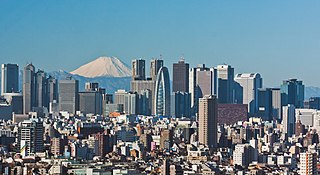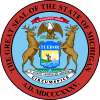An urban township is a designation of a unit of local government in the U.S. state of Michigan as prescribed by section 2 of Public Act 281 of 1986, being section 125.2152 of the Michigan Compiled Laws. The designation allows a general law township or charter township to be considered a municipality under the auspices of the act, and create what is known as a "local development finance authority," in the same way a city or village is entitled. This authority is created in order to, according to the long title of the act, "encourage local development to prevent conditions of unemployment and promote economic growth." [1] Powers entitled to such authorities include the issuance of municipal bonds and tax increment financing.
A local government is a form of public administration which, in a majority of contexts, exists as the lowest tier of administration within a given state. The term is used to contrast with offices at state level, which are referred to as the central government, national government, or federal government and also to supranational government which deals with governing institutions between states. Local governments generally act within powers delegated to them by legislation or directives of the higher level of government. In federal states, local government generally comprises the third tier of government, whereas in unitary states, local government usually occupies the second or third tier of government, often with greater powers than higher-level administrative divisions.

In the United States, a state is a constituent political entity, of which there are currently 50. Bound together in a political union, each state holds governmental jurisdiction over a separate and defined geographic territory and shares its sovereignty with the federal government. Due to this shared sovereignty, Americans are citizens both of the federal republic and of the state in which they reside. State citizenship and residency are flexible, and no government approval is required to move between states, except for persons restricted by certain types of court orders. Four states use the term commonwealth rather than state in their full official names.

Michigan is a state in the Great Lakes and Midwestern regions of the United States. The state's name, Michigan, originates from the Ojibwe word mishigamaa, meaning "large water" or "large lake". With a population of about 10 million, Michigan is the tenth most populous of the 50 United States, with the 11th most extensive total area, and is the largest state by total area east of the Mississippi River. Its capital is Lansing, and its largest city is Detroit. Metro Detroit is among the nation's most populous and largest metropolitan economies.
There are five different methods in which a township may be designated an urban township by the state. [2] Common requirements between all methods are a population requirement, which usually mandates that there be 20,000 residents in a township—though that number can be as low as 10,000—and in one case, the population requirement is not on the township at all, but the county; the population of said county must be over 1,000,000. This, however, only applied to two counties as of 2003 (Wayne and Oakland). [3]

In the United States, an administrative or political subdivision of a state is a county, which is a region having specific boundaries and usually some level of governmental authority. The term "county" is used in 48 U.S. states, while Louisiana and Alaska have functionally equivalent subdivisions called parishes and boroughs respectively.

Wayne County is the most populous county in the U.S. state of Michigan. As of 2017, the United States Census estimated its population as 1,753,616 making it the 19th-most populous county in the United States. The county seat is Detroit, the largest and most populous city in Michigan and 18th-most populous city in the United States. The county was founded in 1796 and organized in 1815.

Oakland County is a county in the U.S. state of Michigan. It is northwest of Detroit and part of metropolitan Detroit. As of the 2010 census, its population was 1,202,362, making it the second-most populous county in Michigan, behind neighboring Wayne County. The county seat is Pontiac. The county was founded in 1819 and organized in 1820.








